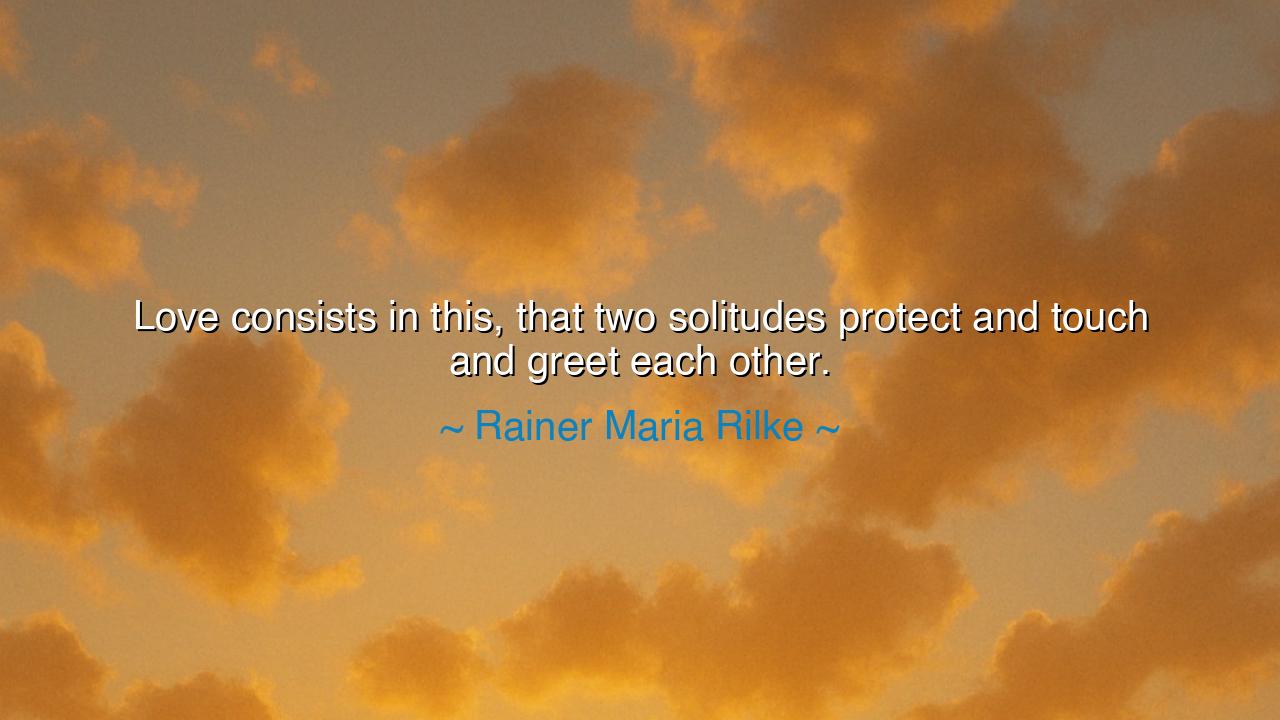
Love consists in this, that two solitudes protect and touch and






"Love consists in this, that two solitudes protect and touch and greet each other." These words, spoken by the great poet Rainer Maria Rilke, offer a profound and tender reflection on the nature of love. At first glance, it may seem paradoxical: how can love exist between two solitudes? How can the very essence of love be described as the coming together of two separate, isolated beings? Yet, Rilke’s words capture the true depth of love—love is not the erasure of the self, but the harmonious meeting of two individual souls, each whole in their own right. Love, in this sense, is not about merging into one entity, but about protecting and honoring the separateness of each person while touching and connecting in the most profound way.
The ancients, too, understood love as a delicate balance between union and individuality. The Greeks, in particular, spoke of various forms of love—Eros, the passionate love between two souls, and Philia, the love of friendship, which involves mutual respect and understanding. Both of these forms of love can be found in the meeting of two solitudes: while Eros seeks a deeper connection, it still honors the independence of each partner. For the Greeks, the highest form of love was one that allowed both individuals to remain true to themselves while also allowing their love to flourish. Socrates and Plato, in their dialogues, spoke often of love as a pursuit of the divine, a way for each individual to elevate their soul while still respecting the boundaries of the other. Love, they believed, does not seek to possess or control; it seeks to elevate both souls to a higher understanding, while still recognizing their solitude.
Consider the legendary story of Pygmalion and Galatea, a tale from Greek mythology. Pygmalion, a sculptor, carved a statue so beautiful that he fell in love with it, and prayed to the gods to bring it to life. The goddess Aphrodite granted his wish, and Galatea, the statue, became a living woman. Their love was not one of equal solitude, for Pygmalion initially had no companion—only his desire for perfection. But the love that grew between them was one that honored their individuality. Pygmalion respected Galatea's autonomy and sought not to mold her in his image, but to allow her to live and grow alongside him. Their story demonstrates how love can be a meeting of souls—each person remains separate, yet in their connection, they become stronger and more whole.
In the same way, Shakespeare’s Romeo and Juliet presents love as a tension between individuality and connection. Romeo and Juliet, two young souls from feuding families, come together in love, yet they never lose their own identity. Their love is not about sacrificing who they are, but about honoring their unique selves while uniting in a shared passion. In the brief moments they are together, they experience the profound beauty of connecting with another soul, yet they remain steadfast in their own individuality. Their love transcends the conflict that surrounds them, showing how love exists when two individuals—each with their own solitude—meet and touch in a way that is both profound and painful.
Rilke’s words echo the reality of love in that true connection does not erase difference; it embraces it. True love is a deep mutual respect for each person’s individuality, their solitude, while allowing for an authentic connection to form. Love is not about forcing someone to become like us or making them fit our expectations. Rather, it is about protecting and honoring the separateness of the other while still reaching across that distance with tenderness and care. To love someone, as Rilke suggests, is to greet them in their wholeness—to offer care and understanding without demanding the loss of their essence.
The lesson here is one of profound acceptance—to love another person is to accept them as they are, with their flaws, their independence, and their unique soul. True love allows for both connection and freedom, for it understands that to truly love is to recognize that each individual has their own path to walk. When we love, we do not ask the other person to give up their solitude, but to share it with us. We must learn to cherish the moment when two solitudes can protect each other, touch each other, and greet each other, without the need for one to lose their independence.
In your own life, think about the relationships you have with others. Are you able to love while still honoring their autonomy and individuality? Do you approach love with the understanding that true connection is built on mutual respect for each other’s solitude? Embrace the uniqueness of those around you, allowing their differences to become the very foundation of your connection. In doing so, you will create relationships that are deep, meaningful, and capable of withstanding the tests of time. Love is not about merging two souls into one; it is about celebrating their differences while coming together in respect, understanding, and care. Let your love be a meeting of solitudes, where both individuals remain whole, and together, you become something even greater.






AAdministratorAdministrator
Welcome, honored guests. Please leave a comment, we will respond soon